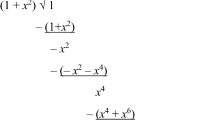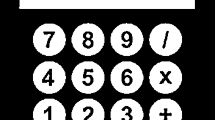Abstract
Indispensability-based arguments for mathematical platonism are typically motivated by drawing an analogy between abstract mathematical objects and concrete scientific posits. In this paper, I argue that mathematics can sometimes help to reduce our concrete ontological, ideological, and structural commitments. My focus is on optimization explanations, and in particular the case study involving periodical cicadas. I argue that in this case, stronger mathematical apparatus yields explanations that have fewer concrete commitments. The nominalist cannot accept these more parsimonious explanations without embracing the stronger mathematics, and this poses a challenge for the nominalist position.
Similar content being viewed by others
Notes
Colyvan alludes to this in a couple of places, including in Colyvan (1998).
For a helpful, book-length discussion of this distinction between ontology, ideology, and structure, see Sider (2011).
For example, mathematical biologist Horst Behncke writes that “the main disadvantage of [this] model is the fact that in nature there is no apparent predator with similar periodic activity.” (Behncke 2000, p. 417).
To be clear, my point in proposing \(2^{*}\) as a replacement for 2 in the original Cicada MES is that \(2^{*}\) more accurately reflects the implicit commitments of biologists’ explanations of the primeness of cicada periods. It is not supposed to be a revision of scientific practice.
Interestingly, some mathematical models that have been developed by biologists to simulate the evolution of prime periods in periodical cicadas assume only the existence of periodical predators with periods of 2 years or 3 years. See e.g. Webb (2001, p. 389).
See Colyvan (2010) for more on these two ‘roads’ to nominalism.
Another line of response to the piecemeal nominalist is to argue that the scattered examples in the literature of MES’s are indicative of a broader class (or classes) of MES that are widespread in science and thus the piecemeal approach is unlikely to be feasible. See for example Baron (2014).
Tallant (2013).
Rizza (2011, pp. 106–109).
Except to the extent that the stronger mathematics may yield extra explanatory power, in which case there is pressure on the piecemeal nominalist of the first kind to recover this extra explanatory power in some other way.
A proof of this result is attributed to Pappus, in his Collections. For further details see Wiegert (2010).
For a summary of the proof, see Hales (2001).
Pincock (2012, p. 213).
ibid.
By way of analogy, assume that we have proved the general result that no chessboard of any size, with opposite corner squares removed, can be tiled using 2 \(\times \) 1 dominoes. And assume that we also have a simpler proof that no chessboard of size 25 \(\times \) 25 or smaller can be so tiled. Now imagine that we have evidence that there has never been any chessboard larger than 25 \(\times \) 25. In some sense, this now makes the weaker result sufficient for our purposes. But nothing about the weaker result justifies the assumption that no chessboard is larger than 25 \(\times \) 25.
It is worth noting, however, that both El Bachraoui’s and Loo’s proofs are “elementary” in the technical sense, and neither requires the use of deep analytical results. For more information on Bertrand’s Postulate and associated results, see http://en.wikipedia.org/wiki/Bertrand%27s_postulate.
Tallant (2013, pp. 2072–2073).
The main defender of the contrary view, arguing for the centrality of mathematical proofs for MES’s, is Mark Steiner. See e.g. Steiner (1978).
In this case 11 remains optimal but it is no longer uniquely optimal, since 13 is also an optimum.
There is also a third potential direction of strengthening of optimization results, namely abstraction.
Pincock (2012, p. 213).
ibid.
A third way in which the stronger mathematical claim may produce a more explanatory MES is in giving the resulting explanation greater ‘modal reach.’
To be clear, nothing in what I have written should be taken to presume that scientists have any explicit awareness that the mathematical portions of their theories have ontological commitment to abstract objects. Rather, the lack of value attached to parsimony of abstracta is being read off from scientists’ pattern of theory choice.
References
Baker, A. (2005). Are there genuine mathematical explanations of physical phenomena? Mind, 114, 223–238.
Baron, S. (2014). Optimisation and mathematical explanation: Doing the Lévy walk. Synthese, 191, 459–479.
Behncke, H. (2000). Periodical cicadas. Journal of Mathematical Biology, 40, 413–431.
Colyvan, M. (1998). Can the eleatic principle be justified? Canadian Journal of Philosophy, 28(3), 313–336.
Colyvan, M. (2010). There is no easy road to nominalism. Mind, 119, 285–306.
El Bachraoui, M. (2006). Primes in the interval [2\(n\), 3\(n\)]. International Journal of Contemporary Mathematics and Science, 1(13), 617–621.
Hales, T. (2001). The honeycomb conjecture. Discrete and Computational Geometry, 25, 1–22.
Lange, M. (2012). What makes a scientific explanation distinctively mathematical? British Journal for the Philosophy of Science. doi:10.1093/bjps/axs012
Loo, A. (2011). On the primes in the interval [3\(n\), 4\(n\)]. International Journal of Contemporary Mathematics and Science, 6(38), 1871–1882.
Lyon, A., & Colyvan, M. (2008). The explanatory power of phase spaces. Philosophia Mathematica, 16(2), 227–243.
Pincock, C. (2012). Mathematics and scientific representation. Oxford: Oxford University Press.
Putnam, H. (1971). Philosophy of logic. New York: Harper & Row.
Räz, T. (2013). On the application of the honeycomb conjecture to the bee’s honeycomb. Philosophia Mathematica, 21, 351–360.
Rizza, D. (2011). Magicicada, mathematical explanation and mathematical realism. Erkenntnis, 74, 101–114.
Saatsi, J. (2011). The enhanced indispensability argument. British Journal for the Philosophy of Science, 62, 143–154.
Sider, T. (2011). Writing the book of the world. Oxford: Oxford University Press.
Steiner, M. (1978). Mathematics, explanation, and scientific knowledge. Nous, 12, 17–28.
Tallant, J. (2013). Optimus prime: Paraphrasing prime number talk. Synthese, 190, 2065–2083.
Webb, G. (2001). The prime number periodical cicada problem. Discrete & Continuous Dynamical Systems: Series B, 1(3), 387–399.
Wiegert, J. (2010). The sagacity of circles: a history of the isoperimetric problem, Loci, July 2010.
Author information
Authors and Affiliations
Corresponding author
Rights and permissions
About this article
Cite this article
Baker, A. Parsimony and inference to the best mathematical explanation. Synthese 193, 333–350 (2016). https://doi.org/10.1007/s11229-015-0723-3
Received:
Accepted:
Published:
Issue Date:
DOI: https://doi.org/10.1007/s11229-015-0723-3




